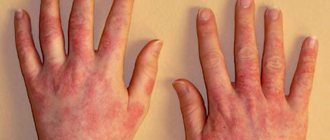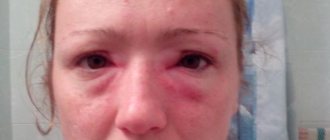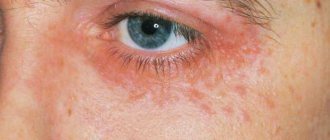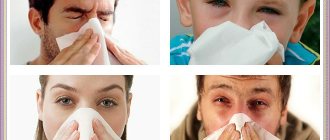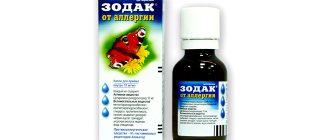The increasing frequency of allergy attacks is a negative consequence of the development of technological progress, affecting people's health. The role of irritant is a variety of substances that enter the body as a result of consumption, inhalation or direct contact. An allergic reaction often manifests itself in the form of watery eyes, itching, dryness and inflammation of the skin of the eyelids. The best treatment for these problems is eye drops. A list of medications with descriptions of characteristics and reviews from specialists will help in selecting an effective allergy medicine.
Types of eye allergies
- Allergic dermatitis - the reaction is expressed in redness of the eyelids, swelling, blistering rashes. The disease is most often caused by increased sensitivity of the body to individual components of cosmetics. Dermatitis also falls into the category of occupational diseases among workers in chemical, processing and food processing industries.
- Allergic conjunctivitis - the chronic form manifests itself in the form of redness of the eyelids and severe lacrimation. In the acute phase of allergies, increased swelling of the mucous membrane of the eyes is noted.
- Pollinose (pollen) conjunctivitis is characterized by a seasonal pattern of exacerbations. The clinical picture includes allergic conjunctivitis, accompanied by sneezing, runny nose, difficulty breathing, and skin reactions.
- Keratoconjunctivitis (spring catarrh) is a seasonal occurrence of papillary formations on the mucous membrane and cornea of the eyes. Most often boys suffer from this disease. An allergic reaction in children manifests itself in the form of itching, lacrimation and photophobia.
- Angioedema of the eyelids (Quincke's edema) is a common allergic complication caused by certain medications or foods. The allergy is expressed in the rapid spread of swelling throughout all parts of the eye. The disease is often accompanied by high intraocular pressure.
In people who constantly use contact lenses, allergic eye pathologies are much more common. The reaction is caused by individual components of lens materials or storage solutions. Plant pollen, animal dander or chemical vapors settle on the surface of the lenses and provoke allergy symptoms.
How to correctly determine what type of drops you need
The choice of drugs to be used for the treatment of allergic conjunctivitis is made by the doctor based on the available clinical data. Antihistamines are the mainstay of treatment. They are used in almost every case of allergies.
Unfortunately, the use of this group of medications does not quickly relieve the symptoms of the disease. Therefore, antihistamines are combined with anti-inflammatory and vasoconstrictor drops.
Vasoconstrictor drops are used to quickly relieve allergy symptoms . The use of a vasoconstrictor reduces swelling and redness.
This effect temporarily alleviates the patient's condition, but does not cure the disease itself. Vasoconstrictor drugs can be used in conjunction with antihistamines.
Anti-inflammatory drops can be hormonal or non-hormonal in nature. Non-hormonal agents are used for moderate severity of symptoms.
Hormonal drugs are used in the acute period of the disease, accompanied by pronounced clinical signs. After the symptoms subside, hormonal drugs are replaced with non-hormonal ones.
When choosing a particular drug, one should take into account the presence of contraindications and individual hypersensitivity to its components. Thus, steroid drugs are contraindicated for cataracts and glaucoma, antihistamines are not used for bacterial infections, the use of vasoconstrictors must be abandoned no later than on the 4-5th day of use.
Antihistamine eye drops for allergies
They block H1 receptors on the surface of cells and eliminate the influence of histamine on them (an amino acid that is a component of protein contained in special mast cells).
Under the influence of certain factors, histamine is activated and cells are released into the general bloodstream. Irritation of H1 receptors by histamine causes external manifestations of an allergic reaction. To eliminate it, use Allergodil.
Membrane stabilizing drugs prevent the release of inflammatory mediators , suppressing the migration of leukocytes to the site of the inflammatory process.
These drugs include eye drops based on cromoglycic acid and ketotifen:
- Opatanol
Local antiallergic agent for instillation into the eyes. Available in the form of a dropper bottle with a volume of 5 ml, filled with a 0.1% solution of the drug.
The active ingredient is olopatodine hydrochloride 1.11 mg/1 ml of the product.
For conjunctivitis of allergic origin, use 2 times a day, 1 drop in each eye. Systemic adverse reactions are possible: weakness, headache, dizziness, changes in the perception of the taste of food.
- Cromoghlin
An antihistamine used for bronchial asthma, as well as for the treatment and prevention of seasonal allergic conjunctivitis. The dose of the drug is determined individually.
May cause side effects : sensation of heat in the area of application, temporary impairment of visual acuity. Affects the ability to drive vehicles and mechanisms that require good reaction and vision from the operator.
- High-chrome
Almost a complete analogue of the above-described “Cromoglin”. Belongs to list “B” (potent drugs). Can be used long-term, as long as the allergen remains active.
Discontinuation of the drug must be done by gradually reducing its dosage. Abrupt withdrawal can provoke an immediate return of all symptoms of the disease.
- Kromosol
A drug based on cromoglycic acid, which has an antiallergic effect. It is most often used as nasal drops, but can also be used in ophthalmic practice. Prescribed 1 drop in each conjunctival sac, 2-3 times a day. Can be used for a long time. Cancellation should be done gradually.
- Alomid
An antihistamine used in ophthalmology. Prescribed for allergic conjunctivitis and other immediate reactions. The active ingredient is lodoxamide tromethamine at a dose of 1.78 mg. Sold in dropper bottles, the volume of which can be 5 or 10 mg. Side effects: blurred vision, burning, tingling, lacrimation.
Vasoconstrictor drops
These eye drops reduce swelling and redness by constricting the blood vessels in the conjunctiva. Such means include:
- Visine
A vasoconstrictor used to quickly relieve swelling and redness. The active ingredient of the drug is tetrizoline hydrochloride. Its dosage per 1 ml of product is 500 mcg.
Available in bottles of 15 ml of ready-to-use solution. Prescribed for patients over 2 years of age. Contraindications: glaucoma, corneal dystrophy. Visine should not be used for more than 4 days.
- Vial
Due to the effect of tetrizoline on the receptors of the autonomic nervous system, Vial has a rapid decongestant and anti-inflammatory effect, constricts the blood vessels of the eye, and eliminates local symptoms of an allergic reaction.
The duration of action of the drug reaches 4 hours , and the development of the pharmacological effect occurs within a few minutes after administration. The drug is applied 1-2 drops into the affected eye. Frequency of use – 2-3 times a day. With prolonged use, signs of irritation, mydriasis, and hyperemia may appear. Therefore, Vial, like other vasoconstrictors, should be used for no more than 3-4 days.
- Okumetil
Local antiallergic drug. The product contains diphenhydramine, naphazoline and zinc sulfate in a ratio of 1:1:1.
Allows you to relieve the symptoms of allergic conjunctivitis and blepharoconjunctivitis, reduce itching and burning, and eliminate the feeling of a foreign body in the eye. Apply 1 drop 2-3 times a day.
There are a number of contraindications for use: closed glaucoma, dry eye syndrome, pregnancy, lactation, diabetes, mental illness.
Vasoconstrictor drugs should not be used for a long time , since their withdrawal may provoke an increase in allergy symptoms.
Rules of application
For the drug to work, it must be used correctly. Inexpensive eye drops are sold without a doctor's prescription, but this does not mean that they are completely safe. The wrong drug or violation of the instructions can lead to complications. This is an increase in intraocular pressure, the development of cataracts. Vascular dysfunction sometimes causes optic nerve atrophy. There are several rules of application:
- store an open bottle in the refrigerator for no more than a month;
- before use, warm in your hand or under running warm water;
- Wash your hands before installation;
- if there is purulent discharge, rinse the eye with warm water;
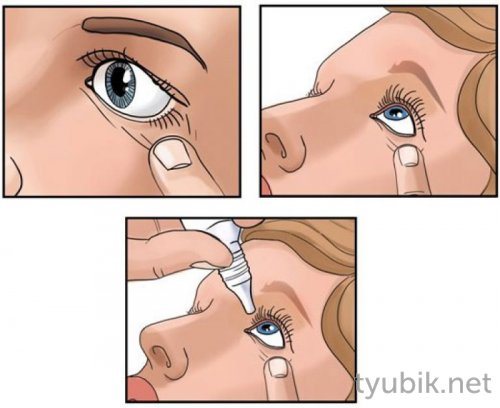
- 1-2 drops are instilled into each conjunctival sac;
- for infectious diseases, apply drops to both eyes, even if one has no symptoms;
- try not to touch the tip of the dropper to the skin or mucous membrane;
- Remove contact lenses and use them only after 20-30 minutes.
Sometimes after instillation there is a burning sensation, a temporary decrease in visual acuity, lacrimation, and photophobia. Some drugs cause systemic side effects: dizziness, drowsiness, headaches, nausea. If such symptoms appear, their use is not recommended.

Anti-inflammatory drops
Eye drops are divided into hormonal and non-hormonal. If allergy symptoms are severe, corticosteroids are prescribed. These are hormonal drugs:
- Dexamethasone
Hormonal anti-inflammatory drug. Available in the form of a white suspension in 5 ml bottles. It has a pronounced anti-edematous and anti-inflammatory effect and is used in cases of severe allergic reactions.
Contraindications to the use of hormones are acute purulent processes of the eye, fungal infection, increased intraocular pressure, hypersensitivity.
Dexamethasone allergy eye drops can be used for no more than 2 weeks . Longer use is possible only under the supervision of a doctor and after measuring intraocular pressure.
However, even with this, the use of hormones significantly increases the risk of a fungal infection. Dexamethasone can be used in patients over 6 years of age. At an earlier age, the drug is not used.
- Maxidex
It is a generic version of dexamethasone, containing the same active ingredient. Indications for use, contraindications and side effects do not differ from those when using the hormonal drug described above.
- Sofradex
A drug based on dexamethasone, additionally containing framycetin and gramicidin. It has not only a long-term anti-inflammatory, but also an antibacterial effect.
Can be used for allergic reactions with attached bacterial or fungal flora. Contraindicated for combined use with nephrotoxic and ototoxic antibiotics (streptomycin, kanamycin, monomycin, gentamicin).
Hormonal drugs quickly relieve inflammation, reduce swelling and redness . As a rule, they are used for a short period of time, under the supervision of a doctor. In addition to the hormone, Sofradex contains antibiotics, so the product suppresses the inflammatory process at the cellular level and helps to cope not only with allergies, but also with other eye diseases.
Eye drops, which contain a non-steroidal anti-inflammatory component, are prescribed rarely and for a short period for allergies.
Preventive agents
Many eye drops are prescribed not only for treatment, but also for the prevention of infectious lesions, the development of irritation when wearing contact correction devices, and increasing IOP. Sulfacyl sodium, Normax, Okomistin are used to prevent infection. In order to prevent the development of diseases associated with constant eye fatigue, increased visual stress, and negative external influences, Visin and Octilia can be used.

How to use correctly
- Before carrying out the procedure, you must wash your hands thoroughly with soap;
- Carefully examine the bottle for damage and check the expiration date of the drops;
- Open the bottle with the drug. In some cases, this will simply require screwing the cap all the way.
- Under no circumstances should you touch the tip of the dropper with your fingers.;
- The head should be tilted back, the lower eyelid should be slightly pulled back with a finger and the gaze should be directed upward;
- The tip of the dropper should not touch the eye;
- The drop should fall into the pocket of the lower eyelid;
- The dropper should be closed after the procedure, without treating it with anything;
- If a special dropper is not available, use a pipette after dousing it with boiling water;
- You need to carefully study the instructions for the drug, since most eye drops, after opening the bottle, are stored in the refrigerator for no more than 28 days, and after that they lose their medicinal properties.
Rules for using drops
Regardless of what type of medicine is used, whether it is given to children or adults, certain rules must be followed:
- before use, wash eyes with clean water and wash hands with soap;
- if 2 types of products are used, then the interval between them is at least 15 minutes;
- store drops according to instructions, some of them may require refrigeration;
- if within 3-4 days the allergy does not become weaker, you need to consult a doctor;
- When using contact lenses, put them on 10 minutes after applying the drops.
And all drops are divided into 3 types: vasoconstrictor, antihistamine and hormonal.
Children's eye drops for allergies
The choice of drugs for pediatric patients should be made with special care. Children under 6 months are recommended to instill Zodak, which has a mild antihistamine effect and has minimal side effects.
Patients aged from six months to a year can be prescribed Zyrtec . When using this drug, it is important to strictly follow the recommended dosage. The use of increased dosages leads to drowsiness and apathy.
After the first year of life, young patients may be prescribed Vibrocil or Prevalin. "Vibrocil" belongs to the category of vasoconstrictors, so its period of use should not exceed 4 days.
It is important to remember that hormonal anti-inflammatory drugs are not used in childhood . Their use is justified only in extremely severe cases of the disease. In this case, the type of drug and its dosage is selected by the doctor. For older children, treatment regimens and medications used are similar to those for adult patients. Dose adjustment may be required.
Antibacterial and antiviral agents
Antibacterial agents act on microorganisms that lead to the development of the disease. Once on the mucous membrane and conjunctiva, they destroy bacteria or viruses, preventing reproduction. Effective for acute or chronic inflammation, used to prevent infections after injuries and surgical interventions. Relieves swelling, redness, pain. Among the most effective medications, there are several inexpensive ones.
- Tsiprolet is used for infectious inflammatory pathologies. Each ml contains 3 mg of ciprofloxacin.
- Levomycetin is a broad-spectrum antibacterial agent. Suitable for long-term use. Well absorbed and tolerated. It helps even in cases where other antibiotics have been ineffective.
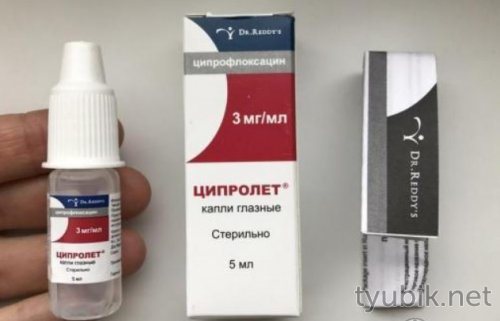
- Tobrex acts on most bacteria. Can be instilled frequently.
- Albucid or Sulfacyl sodium destroys any pathogenic microorganisms. Often causes a burning sensation when instilled.
- Floxal is an antimicrobial agent used for the treatment or prevention of infectious diseases. Together with it, you can use an ointment with the same composition.
- Normax is a safe medicine used even in children under one year of age. It has a wide spectrum of action, is well tolerated, and can be used for prevention.

Antibacterial agents should not be used in case of individual intolerance, pregnancy, or childhood. Sometimes they cause side effects such as burning, photophobia, and lacrimation.
They should be used according to the instructions, without exceeding the dosage and without stopping treatment early.
Drops with an antiviral effect are used to treat viral conjunctivitis and herpes infections. Inexpensive drugs include Oftalmoferon. In addition to destroying viruses, it relieves swelling, relieves pain, strengthens defenses, and eliminates allergic reactions. The duration of treatment is 10-30 days.

Side effects and contraindications
When using antiallergic drops, the following side effects may occur:
- Temporary blurred vision;
- Dry eyes;
- Feeling of “sand” in the eyes;
- Pupil dilation;
- Increased intraocular pressure;
- Headache.
Contraindications:
- It is not recommended to use antiallergic drops for eye inflammation caused by infection;
- Corticosteroid drops are not used for cataracts and glaucoma;
- Patients using contact lenses are recommended to correct their vision with glasses during the treatment period;
- When prescribing drops, age restrictions must be taken into account;
- Allergy drops should not be used if you are hypersensitive to their components;
- It is advisable to carefully study the section on contraindications before using the drops, since they may differ depending on the active substance.
If, when using allergy drops, the symptoms of the disease intensify, side effects occur, or there is no noticeable improvement within 2 to 3 days, you should stop using the drug and consult a doctor.
Why can’t you choose antiallergic eye drops without a doctor?

The task of immunity is to protect a person from various factors hazardous to health. When they enter the body, the immune system begins to produce antibodies that resist viruses, bacteria, and cancer cells, which are also called antigens. Due to this, a person can not get sick for a long time even when exposed to harmful agents.
If the immune system is not working properly, it may see antigens in substances that do not pose a health risk. Considering them to be harmful agents, the body begins to produce antibodies to destroy them. In other words, he is fighting a disease that actually does not exist. This increased sensitivity to certain substances is an allergy. It can manifest itself in different ways, including before the eyes.
The direct causative agents of an allergic reaction can be external and internal factors. The former include pollen, dust, and cosmetics; the latter include food and medicine. Any substance can act as an allergen. Sometimes it takes a lot of research to identify it. Allergies are often caused by the following factors:
- plant pollen;
- pet hair;
- cosmetical tools;
- contact lenses or solution for their care;
- various chemical compounds;
- medications, including eye drops.

In rare cases, allergies are caused by ultraviolet radiation, low air temperature, unfavorable sanitary and hygienic conditions in the work area, infections, etc. Thus, there are quite a lot of factors that can provoke an allergic reaction.
You yourself will not be able to determine the type of allergen, so it is not recommended to buy and use medications without a prescription.
Many people use folk remedies and various drugs that are in their home medicine cabinet for treatment, without knowing exactly the cause of the disease. At best, they will be useless. At worst, self-medication will cause complications. We'll tell you about them later. First, let's list the typical symptoms of eye allergies.


